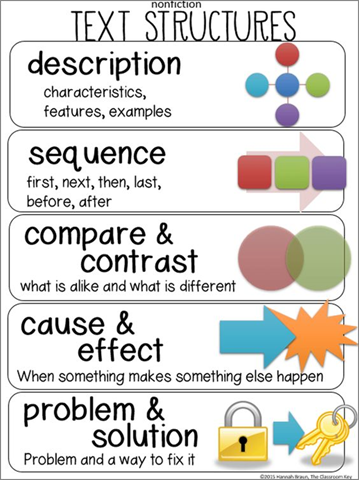Literacy Strategies 4 & 5: Text Structures and Informational and Nonfiction Text Features
Text Structures

Source: https://www.pinterest.com/pin/103231016445614523/
Text Structures
Text structures include:
Description: Describing a topic, person, place, or idea. For example, describing a person or scenery.
Chronological or Sequence: Discussing things in order or as a process. Presenting events in chronological order or from first to last.
Cause and effect: Explaining a cause and its results. For example, examining events and practices that lead to climate change or global warming.
Compare and contrast: Discussing similarities and differences. For example, comparing and contrasting literature, poems, or short stories.
Problem and solution: Presenting a problem and offering a solution. For example, how to protect and preserve endangered species.
Persuasion: Convincing the reader of a certain point of view. For example, convincing a reader that vacationing in Italy is better than vacationing in France.
Common Text Types are also:
Narrative: Tells a story.
Descriptive: Paints a picture with words.
Expository: Explains or informs.
Procedural or Instructional: Provides instructions on how to do something.
Argumentative or Persuasive: Persuades the reader to adopt a particular point of view or take a specific action.
Informational and Nonfiction Text Features
Informational and non-fiction texts contain many features to make the text more accessible. Some of the text features of non-fiction texts are pictures, captions, and maps. Two of the main features are the index and table of contents. The glossary or index directs the reader to specific information in the text and identifies important words and their definitions. The table of contents shows the titles of chapters and their locations in the text. My two favorite features of informational texts are captions and sidebars. A caption is located under a picture or image to describe what it is. A sidebar is located on the side or bottom of the page and explains or elaborates on specific details in the text (Ray, n.d.).
Why Are Text Features Important? Text features are important because they help students to find information in a nonfiction or informational text or nonfiction book more easily. Text features help students to gain information about the text without reading the entire book or passage. Students are able to read nonfictions texts more effectively if they know where to find all the information.
There are many text features, as illustrated in the following diagram.
| Nonfiction and Informational Text Features | |||
| Captions | Charts | Diagrams | Glossary |
| Graphs | Headings | Illustrations | Index |
| Keywords | Maps | Photographs | Pictures |
| Sidebar | Subheading | Table | Table of contents |
| Timeline | Title | Types of print (bold, italic, different colors) | Underlined text |
References
Ray, B. (n.d.). What are text features? The 6 most common text features. ATutor. https://atutor.ca/text-features/
The Classroom Key. (n.d.). Nonfiction text structures. Pinterest. https://www.pinterest.com/pin/103231016445614523/
